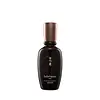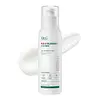What's inside
What's inside
 Key Ingredients
Key Ingredients

 Benefits
Benefits

 Concerns
Concerns

 Ingredients Side-by-side
Ingredients Side-by-side

Water
Skin ConditioningButylene Glycol
HumectantGlycerin
HumectantSqualane
EmollientCaprylic/Capric Triglyceride
MaskingPentaerythrityl Tetraethylhexanoate
EmollientBehenyl Alcohol
EmollientDimethicone
EmollientGlycyrrhiza Uralensis Root Extract
Skin ConditioningOphiopogon Japonicus Root Extract
Skin ConditioningGanoderma Lucidum Stem Extract
Skin ConditioningAcanthopanax Senticosus Root Extract
Skin ConditioningScutellaria Baicalensis Root Extract
AstringentZingiber Officinale Root Extract
MaskingPinus Sylvestris Bark Extract
PerfumingPanax Ginseng Root Extract
EmollientHippophae Rhamnoides Fruit Extract
Skin ConditioningHemerocallis Fulva Flower Extract
Skin ConditioningAdenosine
Skin ConditioningGlyceryl Stearate
EmollientStearic Acid
CleansingCholesterol
EmollientHydrogenated Lecithin
EmulsifyingHydroxypropyl Bispalmitamide Mea
EmollientPalmitic Acid
EmollientSynthetic Fluorphlogopite
Glyceryl Caprylate
EmollientXanthan Gum
EmulsifyingCarbomer
Emulsion StabilisingEthylhexylglycerin
Skin ConditioningCI 77891
Cosmetic ColorantTin Oxide
AbrasiveTromethamine
BufferingDisodium EDTA
Phenoxyethanol
PreservativeParfum
MaskingWater, Butylene Glycol, Glycerin, Squalane, Caprylic/Capric Triglyceride, Pentaerythrityl Tetraethylhexanoate, Behenyl Alcohol, Dimethicone, Glycyrrhiza Uralensis Root Extract, Ophiopogon Japonicus Root Extract, Ganoderma Lucidum Stem Extract, Acanthopanax Senticosus Root Extract, Scutellaria Baicalensis Root Extract, Zingiber Officinale Root Extract, Pinus Sylvestris Bark Extract, Panax Ginseng Root Extract, Hippophae Rhamnoides Fruit Extract, Hemerocallis Fulva Flower Extract, Adenosine, Glyceryl Stearate, Stearic Acid, Cholesterol, Hydrogenated Lecithin, Hydroxypropyl Bispalmitamide Mea, Palmitic Acid, Synthetic Fluorphlogopite, Glyceryl Caprylate, Xanthan Gum, Carbomer, Ethylhexylglycerin, CI 77891, Tin Oxide, Tromethamine, Disodium EDTA, Phenoxyethanol, Parfum
Water
Skin ConditioningNiacinamide
SmoothingIsododecane
EmollientCaprylyl Methicone
Skin ConditioningMethylpropanediol
Solvent1,2-Hexanediol
Skin ConditioningDipropylene Glycol
HumectantPropanediol
SolventGlycerin
HumectantCaprylic/Capric Triglyceride
MaskingHydrogenated Poly(C6-14 Olefin)
EmollientDimethicone/Vinyl Dimethicone Crosspolymer
Skin ConditioningPolyglyceryl-2 Stearate
EmulsifyingC14-22 Alcohols
Emulsion StabilisingC12-16 Alcohols
EmollientGlyceryl Stearate
EmollientStearyl Alcohol
EmollientButylene Glycol
HumectantAcrylates/C10-30 Alkyl Acrylate Crosspolymer
Emulsion StabilisingAmmonium Acryloyldimethyltaurate/Vp Copolymer
C12-20 Alkyl Glucoside
EmulsifyingSodium Polyacryloyldimethyl Taurate
Emulsion StabilisingHydrogenated Lecithin
EmulsifyingPalmitic Acid
EmollientSodium Hyaluronate
HumectantAdenosine
Skin ConditioningTromethamine
BufferingCentella Asiatica Extract
CleansingPolygonum Cuspidatum Root Extract
AntioxidantXanthan Gum
EmulsifyingScutellaria Baicalensis Root Extract
AstringentDisodium EDTA
Camellia Sinensis Leaf Extract
AntimicrobialGlycyrrhiza Glabra Root Extract
BleachingChamomilla Recutita Flower Extract
MaskingRosmarinus Officinalis Leaf Extract
AntimicrobialGlucose
HumectantGluconolactone
Skin ConditioningCeramide NP
Skin ConditioningMelaleuca Alternifolia Leaf Oil
AntioxidantMaltodextrin
AbsorbentMadecassoside
AntioxidantSaccharide Hydrolysate
HumectantPersea Gratissima Fruit Extract
EmollientAsiaticoside
AntioxidantAsiatic Acid
Skin ConditioningMadecassic Acid
Skin ConditioningLaminaria Japonica Extract
Skin ProtectingUlmus Davidiana Root Extract
Skin ConditioningAloe Barbadensis Leaf Extract
EmollientDioscorea Japonica Root Extract
Skin ConditioningViola Mandshurica Flower Extract
AntioxidantWater, Niacinamide, Isododecane, Caprylyl Methicone, Methylpropanediol, 1,2-Hexanediol, Dipropylene Glycol, Propanediol, Glycerin, Caprylic/Capric Triglyceride, Hydrogenated Poly(C6-14 Olefin), Dimethicone/Vinyl Dimethicone Crosspolymer, Polyglyceryl-2 Stearate, C14-22 Alcohols, C12-16 Alcohols, Glyceryl Stearate, Stearyl Alcohol, Butylene Glycol, Acrylates/C10-30 Alkyl Acrylate Crosspolymer, Ammonium Acryloyldimethyltaurate/Vp Copolymer, C12-20 Alkyl Glucoside, Sodium Polyacryloyldimethyl Taurate, Hydrogenated Lecithin, Palmitic Acid, Sodium Hyaluronate, Adenosine, Tromethamine, Centella Asiatica Extract, Polygonum Cuspidatum Root Extract, Xanthan Gum, Scutellaria Baicalensis Root Extract, Disodium EDTA, Camellia Sinensis Leaf Extract, Glycyrrhiza Glabra Root Extract, Chamomilla Recutita Flower Extract, Rosmarinus Officinalis Leaf Extract, Glucose, Gluconolactone, Ceramide NP, Melaleuca Alternifolia Leaf Oil, Maltodextrin, Madecassoside, Saccharide Hydrolysate, Persea Gratissima Fruit Extract, Asiaticoside, Asiatic Acid, Madecassic Acid, Laminaria Japonica Extract, Ulmus Davidiana Root Extract, Aloe Barbadensis Leaf Extract, Dioscorea Japonica Root Extract, Viola Mandshurica Flower Extract
Ingredients Explained
These ingredients are found in both products.
Ingredients higher up in an ingredient list are typically present in a larger amount.
Adenosine is in every living organism. It is one of four components in nucleic acids that helps store our DNA.
Adenosine has many benefits when used. These benefits include hydrating the skin, smoothing skin, and reducing wrinkles. Once applied, adenosine increases collagen production. It also helps with improving firmness and tissue repair.
Studies have found adenosine may also help with wound healing.
In skincare products, Adenosine is usually derived from yeast.
Learn more about AdenosineButylene Glycol (or BG) is used within cosmetic products for a few different reasons:
Overall, Butylene Glycol is a safe and well-rounded ingredient that works well with other ingredients.
Though this ingredient works well with most skin types, some people with sensitive skin may experience a reaction such as allergic rashes, closed comedones, or itchiness.
Learn more about Butylene GlycolThis ingredient is an emollient, solvent, and texture enhancer. It is considered a skin-softener by helping the skin prevent moisture loss.
It helps thicken a product's formula and makes it easier to spread by dissolving clumping compounds.
Caprylic Triglyceride is made by combining glycerin with coconut oil, forming a clear liquid.
While there is an assumption Caprylic Triglyceride can clog pores due to it being derived from coconut oil, there is no research supporting this.
Learn more about Caprylic/Capric TriglycerideDisodium EDTA plays a role in making products more stable by aiding other preservatives.
It is a chelating agent, meaning it neutralizes metal ions that may be found in a product.
Disodium EDTA is a salt of edetic acid and is found to be safe in cosmetic ingredients.
Learn more about Disodium EDTAGlycerin is already naturally found in your skin. It helps moisturize and protect your skin.
A study from 2016 found glycerin to be more effective as a humectant than AHAs and hyaluronic acid.
As a humectant, it helps the skin stay hydrated by pulling moisture to your skin. The low molecular weight of glycerin allows it to pull moisture into the deeper layers of your skin.
Hydrated skin improves your skin barrier; Your skin barrier helps protect against irritants and bacteria.
Glycerin has also been found to have antimicrobial and antiviral properties. Due to these properties, glycerin is often used in wound and burn treatments.
In cosmetics, glycerin is usually derived from plants such as soybean or palm. However, it can also be sourced from animals, such as tallow or animal fat.
This ingredient is organic, colorless, odorless, and non-toxic.
Glycerin is the name for this ingredient in American English. British English uses Glycerol/Glycerine.
Learn more about GlycerinGlyceryl Stearate is a mix of glycerin and stearic acid.
It is used to stabilize the mixing of water and oil ingredients. By preventing these ingredients from separating, it can help elongate shelf life. It can also help thicken the product's texture.
As an emollient, it helps soften skin and supports barrier-replenishing ingredients.
In cosmetics, Glyceryl Stearate is often made from vegetable oils or synthetically produced.
This ingredient may not be fungal-acne safe
Fun fact: The human body also creates Glyceryl Stearate naturally.
Learn more about Glyceryl StearateHydrogenated Lecithin is created from the hydrogenation of lecithin (a group of phospholipids). Hydrogenation is a chemical reaction between hydrogen and another element.
This ingredient is an emollient and emulsifier. As an emollient, it helps soften skin by trapping moisture within. As an emulsifier, it prevents oil and water ingredients from separating.
Palmitic Acid is a fatty acid naturally found in our skin and in many plant and animal sources. In cosmetics, it is usually derived from palm oil. It serves many purposes in skincare, acting as a cleanser, emollient, and emulsifier.
As an emollient, palmitic acid helps soften and smooth the skin by preventing water loss. In cleansers, it helps remove oil and dirt while creating foam.
Its emulsifying properties help stabilize products by keeping water and oil-based ingredients from separating.
This may not be suitable for fungal acne-prone skin, as fatty acids like this can sometimes trigger breakouts in sensitive individuals.
Learn more about Palmitic AcidScutellaria Baicalensis Root Extract comes from the Baikal skullcap or Chinese skullcap plant. This plant is native to Northeast Asia and can be found in China, Mongolia, Korea, and Siberia.
In cosmetics, Scutellaria Baicalensis Root Extract provides antioxidant and anti-inflammatory benefits. This is due to the flavonoid composition of Scutellaria Baicalensis Root Extract.
In Chinese traditional folk medicine, Scutellaria Baicalensis Root Extract is used to help treat lung issues and hypertension.
Learn more about Scutellaria Baicalensis Root ExtractTromethamine helps balance the pH and improve the texture of a product. It is synthetically created.
As an emulsifier, Tromethamine prevents oil and water ingredients from separating. This helps stabilize the product and elongate a product's shelf life. Tromethamine also makes a product thicker.
Tromethamine helps balance the pH level of a product. Normal pH level of skin is slightly acidic (~4.75-5.5). The acidity of our skin is maintained by our glands and skin biome. Being slightly acidic allows our skin to create an "acid mantle". This acid mantle is a thin barrier that protects our skin from bacteria and contaminants.
Oral Tromethanmine is an anti-inflammatory drug but plays the role of masking, adding fragrance, and/or balancing pH in skincare.
1,3-Propanediol, 2-amino-2-(hydroxymethyl)-
Learn more about TromethamineWater. It's the most common cosmetic ingredient of all. You'll usually see it at the top of ingredient lists, meaning that it makes up the largest part of the product.
So why is it so popular? Water most often acts as a solvent - this means that it helps dissolve other ingredients into the formulation.
You'll also recognize water as that liquid we all need to stay alive. If you see this, drink a glass of water. Stay hydrated!
Learn more about WaterXanthan gum is used as a stabilizer and thickener within cosmetic products. It helps give products a sticky, thick feeling - preventing them from being too runny.
On the technical side of things, xanthan gum is a polysaccharide - a combination consisting of multiple sugar molecules bonded together.
Xanthan gum is a pretty common and great ingredient. It is a natural, non-toxic, non-irritating ingredient that is also commonly used in food products.
Learn more about Xanthan Gum